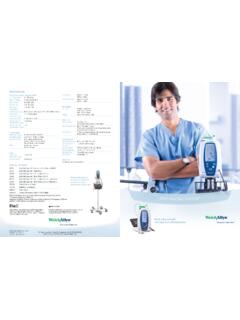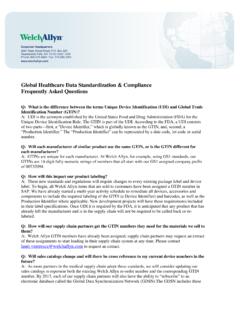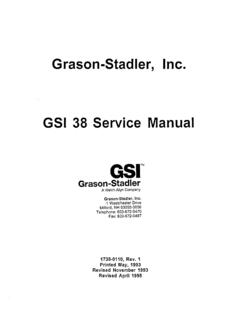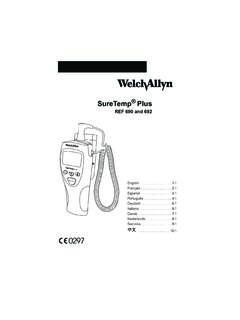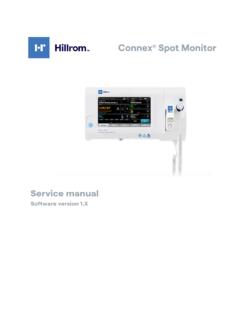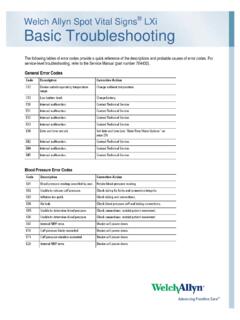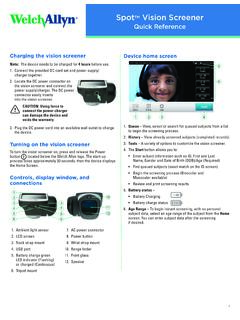Transcription of Telemetry Monitoring on the Medical/Surgical Floor
1 Telemetry Monitoring on the Medical/Surgical FloorIntroductionIn response to the rising acuity levels of patients on Medical/Surgical floors and the perceived need for more robust surveillance of these patients, some hospitals are choosing to invest in Telemetry devices or ECG-capable monitors for their general care beds. This expanded use of cardiac Monitoring is intended to allow hospitals to care for sicker patients in a lower-cost care setting, admit patients faster, ease bottlenecks in the ER and ICU, and avoid costly adverse events by detecting deterioration of patient condition.
2 In addition, some hospitals may be influenced by manufacturers of ECG-capable monitors, who use ECG functionality as a lock-out specification against other types of , research has documented that a significant proportion of patients placed on ECG- Telemetry do not meet the American Heart Association indications for Telemetry Monitoring and are not deemed to be at increased risk for irregular heart Despite the implication of over- Monitoring , the routine use of ECG Monitoring on general care floors may seem like an effective way to improve patient safety and minimize risk.
3 Yet, research on Telemetry has shown that hospitals may overestimate its clinical It appears that physicians routinely make the choice to put patients on Telemetry Monitoring based in part on the often erroneous expectation that Telemetry will lead to prompt recognition and timely intervention for life-threatening changes in patients .2 Furthermore, deploying ECG Monitoring in a general care setting may have unintended negative consequences, such as an increase in nuisance alarms, which creates the risk of alarm fatigue a widely recognized risk to patient In light of the marginal clinical efficacy of ECG Monitoring in the general care setting, its high incidence of nuisance alarms8-13, the added cost of Floor -wide Telemetry systems, and their more demanding workflow and staffing requirements.
4 The utilization of Telemetry for Medical/Surgical patient surveillance may be called into question. A more effective strategy for surveillance of patients in the general care setting should focus on proper patient assessment, accomplished through regular vital signs and clinical observation. Expanded surveillance Monitoring should be based on the existing care protocols and staff skill set found in general care areas Problems with the Use of Telemetry in General CareClinical EffectivenessHealth care delivery organizations are more focused than ever on evaluating the efficacy of interventions and quantifying the link between quality of care and Hospitals want to ensure that any investments produce the desired clinical results.
5 However, in a literature review of the efficacy of cardiac Monitoring , researchers at the Cleveland Clinic concluded that the available evidence suggests that Telemetry infrequently influences physician management decisions for patients at low risk, although it may in a relatively small subset at high risk .15 Studies of Telemetry patients show that only a small fraction of patients have significant arrhythmias that lead to urgent Thus, for those patients on the Medical/Surgical Floor today, many of whom are at low risk according to the AHA guidelines, Telemetry may not significantly influence care patients who do eventually encounter cardiac events.
6 It has been established that there are frequently clinical signs of deterioration hours before cardiac arrests or urgent transfers to the The two most important predictors for patient adverse events have been shown to be Heart Rate/Pulse Rate (HR/PR) and Respiratory Rate (RR).19 While ECG does measure continuous HR, there are other less complicated, less costly methods of Monitoring HR/PR, for example, via pulse oximetry. For many patients on the Medical/Surgical Floor today, it is respiratory failure that poses the most significant Data from a literature review on parameters that trigger rapid response team calls suggest respiratory dysfunctions, such as tachypnea, bradypnea, and desaturation.
7 Are the most common triggers for RRT Other studies find respiratory depression to be the most common reason for code blue events in patients receiving opioids22 and one of the most common antecedents of in-hospital cardiac For these patients at risk for respiratory complications, Monitoring of pulse oximetry (SpO2) and capnography (etCO2) is an earlier indicator of respiratory depression than is respiratory rate from chest wall Furthermore, ECG monitors derive a RR from changes in electrical impedance, which can be problematic due to artifacts and false alarms caused by patient movement and poor lead The RR measured via impedance pneumography has been shown to be less accurate than other methods, including capnography, manual measurements.
8 And contact-free False PositivesLack of early recognition of respiratory depressionWorkflow, Sta ng & Training RequirementsCostHIGHER ACUITY PATIENTS ON MED/SURG FLOORSOVER-ESTIMATION OF CLINICAL EFFECTIVENESS OF TELEMETRYINCREASED USE OF Telemetry Monitoring ON MED/SURGA larm fatigueHIGHER ACUITY PATIENTS ON MED/SURG FLOORSOVER-ESTIMATION OF CLINICAL EFFECTIVENESS OF TELEMETRYF ewer patient alarms/alertsEXPANSION OF VITAL SIGNS SURVEILLANCE AND RESPIRATORY MONITORINGE arly recognition of respiratory depression Matches med/surg sta skill setComplements existing med/surg workflowWorkflow.
9 Sta ng & training requirementsFalse positivesPotential Consequences of Telemetry MonitoringAlthough Monitoring respiratory rate is a useful component of assessing patient status, the numeric reading provides only breaths per minute, not a measure of the quality of ventilation, which, in some patients is crucial. In patients whose airway becomes obstructed, respiratory rate is not a reliable monitor of ventilation, because episodes of obstruction are not usually associated with slow respiratory rates, and there is often chest movement without ventilation.
10 Patients may experience profound hypoventilation due to shallow breathing while maintaining a respiratory rate within normal False Positives and Alarm FatigueOne potential unintended consequence of the overuse of Telemetry Monitoring is the increased chance of artifacts being misinterpreted as abnormal rhythms, which could potentially lead to errors in patient In fact, cases have been reported of patients undergoing unnecessary diagnostic or therapeutic procedures because of artifacts seen during telemetric Monitoring .

